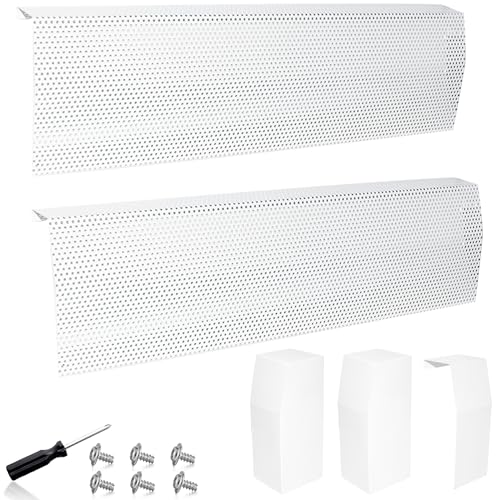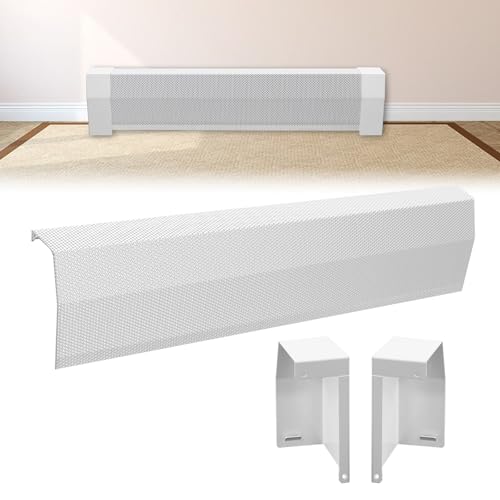Overview: This guide compares reliable electric baseboard heaters, smart thermostats, and replacement covers to help American homeowners select the right components for efficient, safe heating. Below is a concise comparison table of the five selected products featured in the reviews.
| Product | Type | Key Feature |
|---|---|---|
| Mysa Smart Thermostat | Smart Thermostat | High-voltage support, HomeKit/Alexa/Google |
| Mysa Smart Thermostat LITE | Smart Thermostat (Lite) | Wi‑Fi programmable, energy-saving schedules |
| Cadet 36" Electric Baseboard Heater | Electric Baseboard Heater | All-metal construction, requires thermostat |
| Cadet 48" Electric Baseboard Heater | Electric Baseboard Heater | 1000W fast heating, pre-punched casing holes |
| 6ft Steel Slip-On Baseboard Cover | Replacement Cover | 21-gauge steel, rustproof, single-panel design |
Content Navigation
- Mysa Smart Thermostat For Baseboards
- Mysa Smart Thermostat LITE
- Cadet F Series 36" Electric Heater
- Cadet F Series 48" Electric Heater
- 6ft Steel Slip-On Baseboard Cover
- KING K Series 4′ Baseboard Heater
- Retractable Galvanized Steel Covers (2–4ft)
- Gekufa 3ft Baseboard Heater Cover
- Buying Guide: Choosing The Right Baseboard Heater System
Mysa Smart Thermostat For Baseboards

This Mysa Smart Thermostat is engineered for high/line voltage electric heating systems, including 120–240V baseboard and fan-forced heaters. It supports loads up to 1900W at 120V or 3800W at 240V, and requires at least four wires, including a neutral or second live wire. The unit offers Wi‑Fi programming, compatibility with HomeKit, Alexa, and Google Home, and adaptive display features such as brightness control and approach wake functions.
Installation clarity: the listing emphasizes verifying system compatibility before purchase, particularly for older two-wire baseboards. The thermostat is designed for consumers seeking a modern control interface and integration with smart home ecosystems. Built-in safety is tied to correct wiring and load matching, and the device’s compact size and display updates aim to improve user convenience.
Mysa Smart Thermostat LITE

The Mysa Smart Thermostat LITE provides core smart control for high-voltage baseboard heaters with a streamlined feature set. It supports Wi‑Fi programming with a free mobile app and integrates with voice assistants such as HomeKit, Alexa, and Google Home. The manufacturer highlights potential energy savings with customizable schedules and remote control via the app.
Call 888-896-7031 for Free Local HVAC Quotes – Compare and Save Today!
Compatibility notes mirror the standard Mysa unit: this device only works with 120–240V line-voltage systems and requires multiple conductors, which may exclude two-wire older installations. The Lite model focuses on essential remote and scheduling capabilities to help reduce consumption without advanced display features. Buyers should ensure wiring and load capacity before installation.
Cadet F Series 36" Electric Heater

The Cadet F Series 36″ is a 750W, 120V electric baseboard heater constructed from 25-gauge steel with a 20-gauge junction box. The unit requires an external thermostat for temperature control and is fully metal with powder coating for durability. It is a compact option suited to small rooms or supplemental heating applications.
Installation and safety: the heater includes an all-metal build and grounding provisions in the junction box. The design assumes permanent hard-wired installation with a compatible thermostat for user control. For projects where a thermostat upgrade to smart control is planned, this heater pairs with smart line-voltage thermostats if electrical compatibility and load matching are confirmed.
Cadet F Series 48" Electric Heater

The Cadet 48″ baseboard heater operates at 1000W and 120V, offering faster heat output suited for small to medium-sized rooms. It features pre-punched one-inch casing holes and universal wiring at either end to simplify installation. The heater is sheathed in protective steel for optimized heat transfer and longevity.
Call 888-896-7031 for Free Local HVAC Quotes – Compare and Save Today!
Operational notes: a thermostat is required and not included. The heater’s pre-punched holes and universal wiring make it accessible for electricians and knowledgeable DIYers. Its protective steel casing and powder coat finish support long-term use; match the heater output and thermostat type for reliable control and safety.
6ft Steel Slip-On Baseboard Cover

This 6ft Steel Easy Slip-On Baseboard Heater Cover is designed for hydronic and electric baseboards under 6 feet long, with a maximum height of 8.5 inches and width up to 3.25 inches. Constructed from 21-gauge steel with 16-gauge end caps and white stoving varnish, the cover emphasizes safety, rust resistance, and airflow. Single-panel construction protects against direct contact while maintaining heat distribution.
Fit and installation: the manufacturer highlights DIY replacement of old rusty covers and asserts the cover improves aesthetics and safety for households with children or pets. Verify the baseboard dimensions before ordering. The heavy-gauge steel and powder finish are positioned as durable options for long-term use in living spaces and bathrooms when matched to appropriate heater types.
KING K Series 4′ Baseboard Heater

The KING 4K1210BW K Series is a 4-foot / 1000W / 120V baseboard heater designed for hard-wired installation. It uses an aluminum ribbon fin element and includes a full-length safety cutout. The unit is not a plug-in model and requires permanent wiring by a qualified installer.
Design and safety: the aluminum ribbon fin supports even heat transfer across the length of the heater. The integrated safety cutout is intended to reduce risk in case of overheating or element failure. This heater is useful for consumers who need a reliably constructed hard-wired baseboard and plan to pair it with an appropriate thermostat control solution.
Retractable Galvanized Steel Covers (2–4ft)

This retractable galvanized steel cover
Practical considerations: the adjustable design helps match multiple heater lengths with a single SKU, and the included screws and end caps reduce additional purchases. Buyers should measure the pipe-to-pipe dimension and check trim or adjustability requirements. Installation involves standard screw mounting and potential trimming for precise fit.
Gekufa 3ft Baseboard Heater Cover

The Gekufa 3 FT Baseboard Heater Cover
Maintenance advice: after trimming, apply rust-resistant primer or paint to protect exposed edges, especially in humid rooms like bathrooms. This cover is positioned for consumers who need a precise fit and are comfortable performing minor metal trimming and surface finishing during installation.
Buying Guide: Choosing The Right Baseboard Heater System
Selecting a baseboard heater system involves evaluating room size, existing wiring, control methods, safety, and aesthetics. Below are key considerations grouped by purchase perspective.
System Type And Compatibility
- Electric vs Hydronic: Electric baseboard heaters use resistive elements and are common for room heating. Hydronic systems circulate hot water and often require different cover profiles and mounting considerations.
- Voltage And Wiring: Confirm whether your system is 120V or 240V. Smart thermostats like Mysa require line-voltage compatibility and typically need at least four wires including neutral or a second live conductor.
- Thermostat Pairing: Many heaters are sold without thermostats. Determine whether you plan to use a mechanical, digital, or smart thermostat and ensure electrical and load compatibility.
Heating Capacity And Room Size
- Wattage And BTU: Match heater wattage to room size and insulation level. Typical baseboard ratings range from 750W to 1000W for single units; multiple units may be needed for larger rooms.
- Number Of Units: Calculate total wattage and ensure wiring and circuit protection are rated for aggregate loads.
Installation And Safety
- Hard-Wired Installation: Most permanent baseboard heaters require hard-wiring. Use a licensed electrician for code compliance and safe installation.
- Junction Box And Grounding: Verify the heater includes a junction box and proper grounding; modern installations demand secure connections and reliable enclosures.
- Overload Protection: Look for safety features like full-length cutouts or built-in thermal protection to reduce overheating risk.
Control Options
- Mechanical Thermostats: Simpler and low-cost but less precise and not remotely controllable.
- Digital/Programmable Thermostats: Offer schedules and better temperature management, reducing energy waste.
- Smart Thermostats: Enable remote control, integration with voice assistants, and energy monitoring. Ensure compatibility with line-voltage systems and wiring requirements before purchase.
Durability, Materials, And Finishes
- Heater Construction: Steel or aluminum elements are common. Powder-coated finishes improve corrosion resistance.
- Cover Materials: Galvanized or heavier-gauge steel covers resist rust and support long service life, especially in humid areas like bathrooms.
- Endcaps And Mounting Hardware: Check if endcaps and screws are included; omission may increase total project time and cost.
Installation Flexibility And Sizing
- Pre-Punched Wiring Holes: Heaters with pre-punched holes can simplify wiring routing and reduce labor time.
- Adjustable Covers: Retractable or trim-to-fit covers can accommodate multiple lengths but may require DIY trimming and edge finishing.
- Clearance Requirements: Observe manufacturer clearance guidelines to avoid airflow restriction and ensure efficient heat transfer.
Energy Efficiency And Operation
- Scheduling And Smart Controls: Programmable schedules reduce run time and electricity use. Smart thermostats with algorithms may further optimize consumption.
- Load Matching: Avoid oversizing control devices; ensure thermostats are rated for the heater’s wattage at the system voltage.
Aesthetic And Household Considerations
- Child And Pet Safety: Single-panel covers and guarded designs reduce the risk of direct contact with heating elements.
- Room Appearance: Choose covers and heater finishes that match trim and decor. White powder-coated finishes are common for blending into walls.
Comparison Perspectives
- Professional Installer Perspective: Prioritize junction box quality, wiring options, pre-punched holes, and load ratings for compliance and speed of installation.
- Homeowner DIY Perspective: Favor plug-and-play compatibility where available, adjustable covers, and clear installation instructions. Confirm wiring and local codes before attempting electrical work.
- Energy-Focused Perspective: Select smart thermostats with scheduling, and ensure accurate load matching to maximize efficiency gains.
When building or upgrading a baseboard heater system, cross-check heater output, thermostat compatibility, wiring requirements, and cover dimensions. Each element—heater, thermostat, and cover—plays a role in performance, safety, and longevity. Refer to manufacturer documentation and local electrical codes during selection and installation.
Tips for Getting the Best HVAC Prices
- Prioritize Quality Over Cost
The most critical factor in any HVAC project is the quality of the installation. Don’t compromise on contractor expertise just to save money. - Check for Rebates
Always research current rebates and incentives — they can significantly reduce your overall cost. - Compare Multiple Quotes
Request at least three estimates before making your choice. You can click here to get three free quotes from local professionals. These quotes include available rebates and tax credits and automatically exclude unqualified contractors. - Negotiate Smartly
Once you've chosen a contractor, use the proven strategies from our guide — How Homeowners Can Negotiate with HVAC Dealers — to get the best possible final price.
